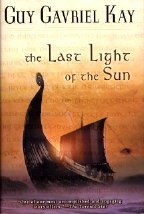The Last Light of the Sun
Guy Gavriel Kay
ROC / Penguin Putnam
US Hardcover First
ISBN 0-451-45965-2
Publication Date: 02-03-2004
Pages; Price: 501; $24.95
Date Reviewed: 10-03-04
Reviewed by: Katie Dean © 2004

REFERENCES
COLUMNS
|
|
|
The Last Light of the SunGuy Gavriel KayROC / Penguin PutnamUS Hardcover FirstISBN 0-451-45965-2Publication Date: 02-03-2004Pages; Price: 501; $24.95Date Reviewed: 10-03-04Reviewed by: Katie Dean © 2004 |
|
|
REFERENCES |
COLUMNS |
'The Last Light of the Sun' is a fantasy novel steeped in history. In itself reminiscent of the traditional Sagas, Kay's latest work draws heavily upon Norse history and legend. Kay's fantasy world is a barely disguised version of northern Europe in the Dark Ages. His story focuses upon three main characters and demonstrates how their lives and those of their friends and families can become intertwined through historical accident. Kay creates a compelling story and tells it very well.
So many fantasy novelists feel the need to create something so fantastical and different that they sacrifice any possibility of believing in the worlds and stories to which they give birth. Guy Gavriel Kay resists this temptation, instead creating a fantasy that is firmly based in reality. He has created original names for the lands and divinities of which he writes, but their origins remain recognizable. The Erling raiders of the north, warriors and privateers, worshipping the Pagan gods Thunir and Ingavin, have clear roots in the Norse Vikings. These fierce warriors launch raids on their neighbours, amongst which number the Anglcyn and Cyngael peoples who worship a single God, Jad. These peoples are also recognizable as the English and Welsh. The style of raids as described by Kay, mimic the original Viking raids that plagued the British Isles in the eleventh century. This is not to suggest that Kay has simply taken historical fact and reworked it to serve his own purpose; rather, he has made good use of fact in order to create a very believable fiction.
Kay's skill as a storyteller is apparent throughout this novel. He opens with one character embarking upon a dangerous adventure, only to leave the reader hanging whilst he introduces his next key character. Ultimately we are introduced to three men, all of whom are sucked into seemingly unrelated adventures. Kay succeeds in maintaining interest in all three stories, gradually weaving them together. Along the way he introduces a large cast of characters, some playing major roles, some serving his authorial purpose in a single chapter. Kay uses a style of terse, short sentences to reveal his character's thoughts and feelings, creating a cast of people sufficiently complex to be believable.
Like many fantasy novels, 'The Last Light of the Sun' is a book about battle between opposing forces. The goal towards which its protagonists aim is peace and stability. However, as in real life, the division between good and evil is not clear-cut. In the main, the Erlings are painted as the forces of evil, ignorant in their worship of pagan gods and vicious in their constant warring and love of killing. In contrast, the Anglcyn King, Aeldred, seeks to establish peace with his neighbours and encourage worship of the true God, Jad. By allowing the reader to see the differing viewpoints of each race, Kay offers a subtle yet pertinent message. Each has their own reasons for pursuing their particular way of life and each may be right.
Based in history, built upon fantasy, 'The Last Light of the Sun' is not only a well-written and entertaining story, it suggests a call for increased understanding and tolerance as a means of overcoming national and political divide today.